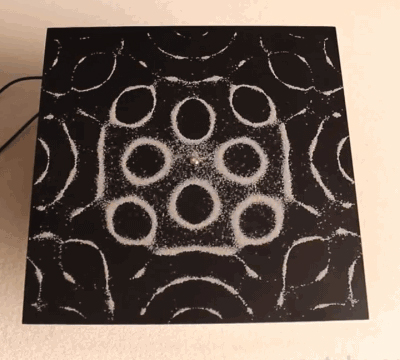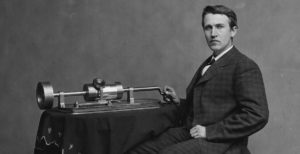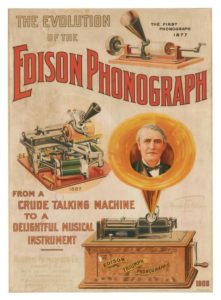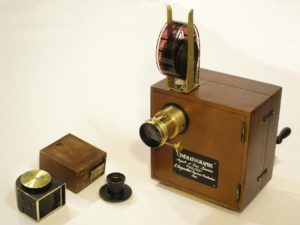BITTAKOPHONE
As visitors enter room of Stanley automobiles from the lobby area in the Marshall Steam Museum, they encounter a display of artifacts which helped define the era of the late 1800s and early 1900s. On display are Edison phonographs, a first-generation commercial AM radio, a Kellogg wooden-box, hand-crank telephone, clips of Marshall home movies, a model Stanley steam car, a penny-farthing, a still-operational steam-powered popcorn maker, and other artifacts. If you ask a visitor, “What inventor comes to mind when seeing this collection of memorabilia?” usually Thomas Alva Edison (1847-1931) comes to mind. One wonders if Israel Marshall (1850-1911) wasn’t partly inspired by reading about Edison’s inventions as the two men lived during the same portion of the industrial revolution. Edison’s first patent was issued in 1869 (Electric Vote Recorder) and Marshall’s first patent application occurred in 1886 (Water-proof Building-paper; awarded 1887).
 Many individuals view the importance of the Edison phonograph as being a primary income source which Edison tapped to generate the cash stream necessary to fund his many experiments necessary in the commercialization of the electric lamp. By 1877 as Edison worked on the phonograph, mankind understood the fundamentals of sound and how it moved through the air, water, and walls. In the 1840s, Christian Doppler had mathematically explained why sound from train whistles shifts pitch as it passes the listener. The first visualizations of sound waves occurred in the later 1700s when Ernst Chladni visualized sound with what become known as Chladni patterns (pictured at left). Chladni patterns are created on thin resonance plates by sprinkling a fine sand uniformly across the resonance plate’s surface and then allowing the plate to vibrate in harmony with any sound the plate receives. The Phonautograph, patented in 1857, is the earliest device known to have recorded sound and simultaneously produce a visual pattern of the sound thus preserving the sound’s waveform for future study.
Many individuals view the importance of the Edison phonograph as being a primary income source which Edison tapped to generate the cash stream necessary to fund his many experiments necessary in the commercialization of the electric lamp. By 1877 as Edison worked on the phonograph, mankind understood the fundamentals of sound and how it moved through the air, water, and walls. In the 1840s, Christian Doppler had mathematically explained why sound from train whistles shifts pitch as it passes the listener. The first visualizations of sound waves occurred in the later 1700s when Ernst Chladni visualized sound with what become known as Chladni patterns (pictured at left). Chladni patterns are created on thin resonance plates by sprinkling a fine sand uniformly across the resonance plate’s surface and then allowing the plate to vibrate in harmony with any sound the plate receives. The Phonautograph, patented in 1857, is the earliest device known to have recorded sound and simultaneously produce a visual pattern of the sound thus preserving the sound’s waveform for future study.
 Edison’s tin-sheet phonograph (pictured right) not only recorded sound, but the device preserved the sound for faithful play back as well as manipulation. This accomplishment led to Edison becoming known as “The Wizard of Menlo Park”. The ability to faithfully reproduce recorded sound is the obvious aspect of the phonograph that people think about when they remember the invention of the phonograph. However, there is one other aspect of the phonograph that astounded mankind once it was realized. What is this other aspect of the phonograph’s development that may consider more important than the faithful reproduction of sound? We’ll also tell you in the answer what a Bittakophone is.
Edison’s tin-sheet phonograph (pictured right) not only recorded sound, but the device preserved the sound for faithful play back as well as manipulation. This accomplishment led to Edison becoming known as “The Wizard of Menlo Park”. The ability to faithfully reproduce recorded sound is the obvious aspect of the phonograph that people think about when they remember the invention of the phonograph. However, there is one other aspect of the phonograph that astounded mankind once it was realized. What is this other aspect of the phonograph’s development that may consider more important than the faithful reproduction of sound? We’ll also tell you in the answer what a Bittakophone is.
Answer
 Until 1877 and Edison’s perfection of the phonograph, it had only been possible to capture or preserve the world around us. The photographic process, begun in the early 1800s, captured rudimentary images of objects (from the light they reflected) as they existed during the brief time window the photographic material was exposed to light. The phonautograph, developed in the mid-1800s, allowed for the visualization of sound waves. Edison’s development of the phonograph in 1877 brought the ability to faithfully reproduce something recorded earlier along with the ability to time-shift what had been recorded.
Until 1877 and Edison’s perfection of the phonograph, it had only been possible to capture or preserve the world around us. The photographic process, begun in the early 1800s, captured rudimentary images of objects (from the light they reflected) as they existed during the brief time window the photographic material was exposed to light. The phonautograph, developed in the mid-1800s, allowed for the visualization of sound waves. Edison’s development of the phonograph in 1877 brought the ability to faithfully reproduce something recorded earlier along with the ability to time-shift what had been recorded.
Consider a simple musical metronome producing a discernable ‘click’ at a very precise interval to set the beat of music being played by an artist. Recorded using an Edison phonograph, when played back, the time space between the clicks was an accurate reproduction of what had occurred when the recording was taken. Like a photograph, the recording of the clicks is an accurate future reference of the sound captured which may be heard at some future date or dates provided the recording does not become damaged in the interim.
However, by varying the speed that the recording was played back, time-shifting of the recorded material occurs which was a totally new concept to be explored. Played back at twice the recorded speed, the clicks occur at a frequency of half the time interval they were recorded. Played back slower than the recorded speed, the clicks occur at twice the time interval they were recorded. With this change in playback speed, the frequencies of the recorded sound also shifted depending on the playback speed. This ability was soon recognized as mankind could ‘create’ the Doppler Effect and use it to advantage.
Edison worked for Western Union prior to his invention of the phonograph and the ability to record the dots and dashes of a telegraph message for retransmission later was one of the ideas he worked on. Being able to record a message, and then play it back faithfully at a much higher speed, effectively compressing the time it took to transmit the message, would allow more information to be passed along a telegraph wire than was possible with current technology and most importantly, do so without changing the information being transmitted. In another application, the faster or slower playback could change the very nature of the recorded material when it was played back! The Edison phonograph had unexpectedly unleased more profound ramifications for the use of Edison’s recording technology.
When a person dies their voice and manner of speaking are lost. Now, through Edison’s invention, the tonal aspects of an individual’s speech and that individual’s speech pattern are preserved for the future. In the 21st century we can be inspired by words Roosevelt or Kennedy spoke in the 20th century. Visitors to the Marshall Steam Museum hear Tom Marshall passionately talking about the Stanley steam cars he loved so much and sought to preserve for future generations.
 Additionally, Edison’s phonograph allowed for a continuous clip of sound to be recorded and then be time-shifted in playback to be listened to multiple times. That playback could be compressed or expanded. It wasn’t until 1895 that the Lumière brothers would invent the Cinématographe (left) for capturing continuous segments of imagery for time-shifted playback at any time in the future. Edison, in 1910, combined aspects of his phonograph and the Lumière brothers’ Cinématographe to invent the kinetoscope – a device allowing viewers to experience moving imagery with synchronized sound.
Additionally, Edison’s phonograph allowed for a continuous clip of sound to be recorded and then be time-shifted in playback to be listened to multiple times. That playback could be compressed or expanded. It wasn’t until 1895 that the Lumière brothers would invent the Cinématographe (left) for capturing continuous segments of imagery for time-shifted playback at any time in the future. Edison, in 1910, combined aspects of his phonograph and the Lumière brothers’ Cinématographe to invent the kinetoscope – a device allowing viewers to experience moving imagery with synchronized sound.
 Today, our mobile devices capture light and sound together, faithfully store what was captured, and allow for its replaying multiple times in the future. We often modify earlier-recorded material to shift the colors of recorded light and manipulate the tonal aspects of sound upon playback in the 21st century and think nothing about doing such. In 1877, the fact that mankind now could even make such changes was mind-blowing as sound became the first medium to be so manipulated. Today, everything that is transmitted to and from our mobile devices is time-shifted in multiple ways.
Today, our mobile devices capture light and sound together, faithfully store what was captured, and allow for its replaying multiple times in the future. We often modify earlier-recorded material to shift the colors of recorded light and manipulate the tonal aspects of sound upon playback in the 21st century and think nothing about doing such. In 1877, the fact that mankind now could even make such changes was mind-blowing as sound became the first medium to be so manipulated. Today, everything that is transmitted to and from our mobile devices is time-shifted in multiple ways.
Edison’s first sketches of his ‘talking machine’ used the word “phonograph” as a potential name. During the device’s development Edison came up with more than 50 alternative names in an attempt find the perfect name. Under consideration were such names as; ‘Anitphone’ meaning back-talker; ‘Kosmophone’ meaning universal sounder; ‘Auto-Electrograph’ meaning electric pen; ‘Atmosphone’ meaning fog sounder or vapor-speaker; and ‘Bittakophone’ meaning parrot speaker.
